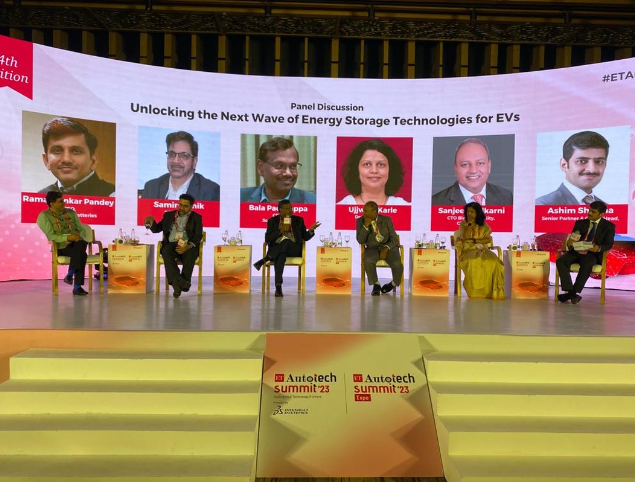
Here are the 5 key takeaways from the Summit.
1.Tier-1 suppliers turn technology providers
The Tier-one companies are transforming themselves from suppliers to technology providers. The session on “Suppliers to technology providers – Role of Tier-ones in the Disruptive Era”, discussed and debated the new opportunities, industry gaps, challenges, and how companies can tap the technology trends better.
Sanjay Gupta, President and CEO, Advanced Technologies, Spark Minda, said that Indian tier-ones are all set to move forward with hunger in their belly and are all set to defeat their global counterparts.
Dr. S J Dhinagar, Head & SVP, Vehicle Engineering, Ola Electric, said, “We have an ecosystem where components come packed with the software and electronics.”
Amit Jain, Group CTO and ED, UNO Minda, said, “Our strategy includes electrification of our legacy products.”
Anand Bhangaonkar, Head, R&D, Piaggio India, said that technology can evolve and can go any way. He also added that in the EV segment, Piaggio is partnering with different players.
Dheeraj Kumar Tiwari, Founder & CEO, CapGrid, said that the idea of CapGrid is to provide complete transparency of the supply chain to the customers.
2. The prolonging life of ICE
The need for cleaner and sustainable mobility, increasingly stringent emission norms, government policies, and their impact on the powertrain; and the energy-mix of the auto industry ere brought to the fore at the Summit. The exclusive CTO session on “Powertrain Technology Mix for the Next 10 Years” delved deep into how powertrain technologies will evolve in the various segments of the automotive industry.
Rajendra Petkar, President & CTO, Tata Motors said that the EVs will make a significant penetration in the coming years but ICEs have also come a long way and sit at the pinnacle of technology today. In terms of energy efficiency ICEs are one of the finest energy converters from pure energy to mechanical power.
“In the next decade, ICEs will continue to evolve till we reach net zero at the national level. This is owing to the government’s investment in alternative fuels, biofuels, and CNG. Going forward, the focus will be on creating a fuel agnostic engine. Till the net zero technologies become completely commercially affordable with respect to the charging infrastructure, the ICEs will continue even though they will taper down from where we are today,” he said.
Sumeet Dhar, COO & CTO Electra EV, said, “The ease of converting ICE vehicles to an alternative fuel vehicle is a low hanging fuel; the ICE technology is not going away so easily. But the base at which the development of EVs is happening will be much faster than what happened for ICEs.”
Dhar said that the mass adoption of EVs is not going to be easy owing to the current pace of technology, cost and infrastructure. The advances in EVs are going to happen in multiple ways.
3. Too early to write off Lead acid battery technology
As the EV mega trend progresses, technology solutions to power them also are advancing. The session on “Unlocking the Next Wave of Energy Storage Technologies for EVs” focused on new battery chemistries beyond Lithium-ion, advancements in metal-air technology, fully indigenous battery solutions, and more.
Bala Pachyappa, CEO, Sodion Energy, talked about how the Lead acid battery technology, which is being written off, should be in the discussion about battery technology. He also talked about sodium as a replacement for Lithium batteries.
Ramashankar Pandey, CEO, Tata Green Batteries said, “We are trying to create a marketplace where every battery will be given a code to track where they are going.”
Ujjwale Karle, Deputy Director, ARAI, said, “Reduce, reuse and recycle will play a very important role in the battery industry.”
Samir Yajnik, CEO and ED, Electra EV, said that India is at a tipping point where it can develop technology that can lead and dominate the world space.
4. How will softwarisation redefine the automobile?
CXOs from leading organisations discussed in detail the impact of the growing global SDV (Software Defined Vehicle) trend on design and development of vehicles. The session on “Softwarisation of the Automobile” also covered the aspects of software-led monetisation opportunities, addressing cybersecurity risks, and leveraging Indian software engineering talent for growth, among other topics.
Mahesh Babu, Global CEO, Switch Mobility, said that 70% of efforts go into software development in the automotive industry. “When we look at electrification, the innovation happens around race cars in the developed nations. But in India it happened according to the country’s needs,” he added. He also said that electrification and software put together can change the lives of people.
Brahmanand Patil, President & MD, Vector Informatik India, said that India is not just sitting on mechanical cars but cars with softwares that are relevant to India.
Prasanth Doreswamy, President & CEO, Continental India, said “Iphone has succeeded in separating software from hardware, something that the automotive industry hasn’t been successful yet.”
5. Industry – Academia collaboration comes to centre-stage
In this disruptive age, industry-academia collaboration is a necessity to develop new, innovative and more efficient solutions. The session on “ Industry – Academia collaboration is more crucial now than ever before” discussed how industry players and academic institutions should come together for mutual gains.
IV Rao, Distinguished Fellow, TERI, said that auto companies should hire students as interns for 3-6 months to give them on ground experience of how the industry works and to help them be Industry ready graduates.
He also explained how Industry looks at ready-to-adopt solutions and that the gap can be filled by startups which need support from incubation centres.
Dr. KC Vora, Professor Emeritus – COEP Technological University and Former Senior Deputy Director, ARAI said, “I can say that there are challenges but there is scope for academia and industry to work together.”

















